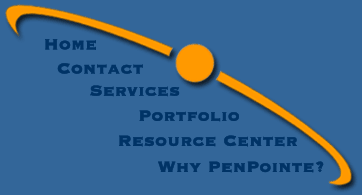

| PenPointe Tip Sheet |
| Topic: The Eight Essentials of Web Site Creation
By Steven Weathers To understand the major trends of web site creation, we must first go back to the very beginning of the Internet. In the early 1990s, the Internet was primarily text-based. Universities and scientific research facilities used the Internet to communicate ideas and project statistics. Around 1993, however, browser applications were developed that allowed computer users access to the Internet with the added function of displaying web pages that fit within a structure of a web site. The textual became visual, much like the evolution from book to film in the early 1900s. With the introduction of web browsers, the Internet was changed forever, and after a few short years, we've learned that the Internet is ever-changing. So it is with web site creation. What worked five years ago is ancient history in web years. What was hip last year is now out of style. Rather than analyze what's popular right now, I would like to present Eight Essentials of Web Site Creation. These are principles that have resurfaced and remained from the millions of web pages that change everyday. 1. A great web site must have a quickly loading home page. Two years ago, web designers were taught the "10 Second Rule," that web pages should load within 10 seconds. With the recent rise of high speed Internet access at work and home, however, the 10 second rule has shortened to 2 seconds or less. Within the past year, an added feature to graphic programs has allowed web designers to save images for the Internet, and some programs even estimate how long it will take for an image to download on a 28.8 modem. Now web designers can “budget?image sizes for a home page, keeping all of the text and images to a total of 60 k or less to insure instant loading. 2. A great web site must have clean design. No matter if it's flashy or static, colorful or monotone, well designed web pages must have an overall design that compliments the company's or organizations visual identity. This is where custom web design is far better than HTML template pages. In 1996, most web graphics were cartoons and rainbow colored buttons. Although that worked in 1996, web sites that are still cluttered with hopping rabbits and flashing "under construction" road signs will threaten a company's positioning on the Internet. 3. A great web site must have intuitive navigation. Have you ever visited a web site that has four rows of navigational buttons in four different places on the web page? Time has taught us that computer users have very little patience for figuring out where they need to go on a web site. I recommend that all of the navigational options stay in the same place on every page. This will create easy navigation for the visitor. 4. A great web site must offer rich content. One of the best ways to keep traffic coming to your web site is adding content to a great tank of articles, press releases, testimonials, bios, case studies, etc. Empty web pages with "under construction" or two simple sentences that say nothing about your company will only disappoint web visitors. 5. A great web site must be updated frequently. Don't let your competition pass you by in this area. Daily updates are best. Weekly updates are good. Monthly updates are acceptable. Quarterly updates are unsatisfactory. Yearly updates are embarrassing. You can save costs with frequent updates by hiring a web master that will update your site as part of his or her job description. Another cost effective way to update your web site is pay your web site creator for programming that will allow you to update your web site in an admin area. 6. A great web site will respond to contact requests within 24 hours. Have you ever submitted a contact form to a web site and never received a response? A couple of years ago, that was common. Now it's unacceptable. If a web user contacts you through the web site, it is essential that you contact the visitor within one business day. A handy trick is to setup an automatic response, so when someone fills out a contact form, an email will be sent instantly saying that you will follow up on their request very soon. Just make sure you do. 7. A great web site is fueled by marketing efforts. If you build it they will not come unless you advertise it. You can promote your web site online with search engine placement, multiple links, rich media advertising, emails, etc., and you can promote your web site off-line with the web address listed on everything you print, from business cards to letterhead, to brochures to faxes. You can also host a launch party with your new web site on display. You can send direct mail postcards advertising your new web site. You can purchase radio ad space, print ad space, television ad space. Do it all, and do it often. 8. A great web site has a web
statistics report that is studied daily or weekly. How do
you know who's coming to your web site and how they're finding you?
Read your web stats report! Learn which keywords they enter into
search engines to find your web site. Track the servers from which
they surf. Note the pages they hit when you set up a landing page.
Some of the greatest secrets in driving web traffic can be found from your
web stats report. Watch it closely, and update your web site accordingly. |
| PenPointe accuracy. PenPointe focus. PenPointe excellence. |
